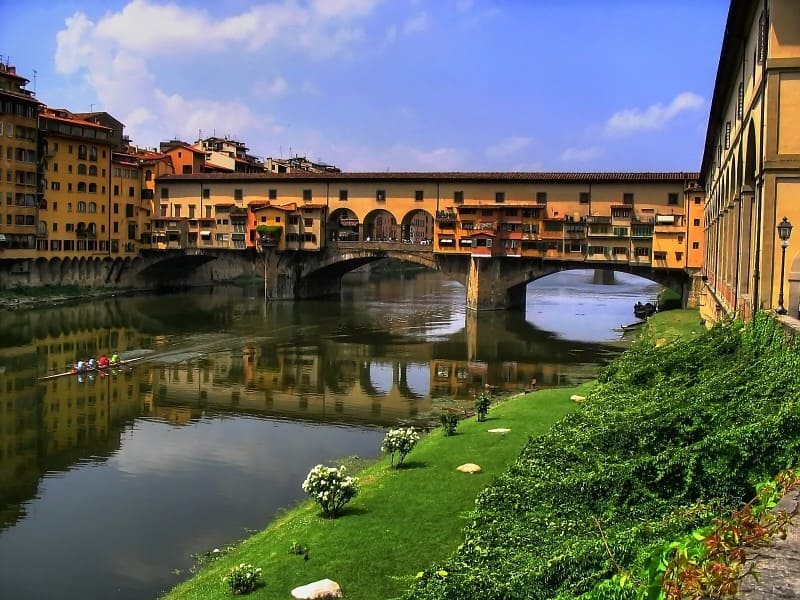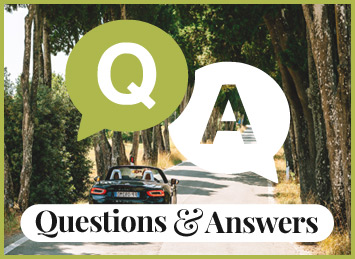A useful Florence Travel Guide to guide you discover the city at its best
Anyone having a holiday in Tuscany can’t miss visiting the wonderful and magnificent art town of Florence, the Renaissance capital of Europe. You really need a useful Florence Travel Guide, cause there is an endless list of things to see and admire.
Florence is the city of art par excellence, synonymous with all that is beautiful; home to poets, sculptors, and artists, from Dante and Boccaccio to Brunelleschi, Botticelli and Michelangelo, just to mention a few. You need a well done Florence travel guide.
A travel guide to the City of Art in all Senses
Florence is truly a city of art in all senses, not only in the monuments, the galleries, the museums and the churches, but also in everyday life, from the narrow charming streets and corners, to the ancient vaulted shops selling antiques and paintings.
The Renaissance movement of the 15th century started here under the patronage of Cosimo dè Medici, when there was a great artistic and cultural development and an incredible blossoming of creativity.
Some of the greatest artists of all times, like Leonardo da Vinci, Botticelli, Brunelleschi, Vasari, and Michelangelo, were active during this period of unprecedented cultural prosperity.
The wonders and attractions of Florence are countless! There’s really so much to see and do, that one can literally get lost! So I suggest you choose just some sights and concentrate on them.
Florence Top Sights and Attractions: your useful Florence travel guide
Here is a list and brief guideline of what to see and visit in Florence:
1. Santa Maria Novella Church
One of the most beautiful churches in all Italy, characterized by a wonderful facade with multicolored marbles. At its interior, the church is filled by great masterpieces of art: a pulpit by Brunelleschi, a crucifix by Giotto, the fresco cycle by Filippino Lippi in the Cappella Strozzi, the beautiful frescoes by Domenico Ghirlandaio in the Cappella Tornabuoni, the fresco of the Trinity by Masaccio, the fresco the Flood by Paolo Uccello.
2. The Duomo and the Cupola del Brunelleschi
The Duomo, or Cattedrale di Santa Maria del Fiore, in Piazza San Giovanni, is a very large cathedral with a pink, white and green marble facade, universally renowned for the beautiful terracotta Dome of Brunelleschi.
Climb up the 414 steps of the Campanile to enjoy one of the best views over the city of Florence and the dome itself. Within the Duomo, you can admire works by Giotto, Donatello, Michelozzo, Paolo Uccello, and many others.
West of the Duomo stands the Baptistery of San Giovanni with its octagonal shape, rising over the remains of a Roman palace of the 1st century AD. Its bronze doors are a true masterpiece, especially the east door by Lorenzo Ghiberti, that Michelangelo described as the “gates of Paradise”.
3. Piazza della Signoria and Palazzo Vecchio
The wonderful Piazza della Signoria is the very heart of Florence, adorned by an array of statues: Giambologna equestrian statue of Cosimo I dè Medici, Ammannati’s imposing Neptune Fountain, a copy of Donatello’s il Marzocco, a copy of Michelangelo’s David, and Bandinelli’s Ercole e Caco.
Under the beautiful Loggia dè Lanzi, begun in 1376 and serving to meet foreign emissaries, you can admire Benvenuto Cellini’s Perseus, The Rape of the Sabine and Hercules Slaying the Centaur by Giambologna.
The majestic Palazzo Vecchio (the town’s hall), probably designed by Arnolfo di Cambio, hosts a lot of masterpieces of art and beautiful rooms to visit, such as the Salone dei Cinquecento, the Sala dell’Udienza, the Sala dei Gigli, and the Sala delle Carte.
4. The Gallery of Uffizi
Next to Palazzo Vecchio you’ll find the famous art gallery of Uffizi, the greatest collection of Renaissance paintings in the all world, including treasures by Michelangelo, Tiziano, and Raffaello, amongst many others. I’ve dedicated a full post to the Gallery of Uffizi and its main masterpieces. Considering the long queues, I suggest you buy the tickets for the Uffizi Gallery online at their Official Website.
5. The Gallery of Accademia
That’s the first academy of drawing, founded in 1563 by Vasari, Bronzino, and Ammannati. Here you can admire the original Michelangelo’s David. You can buy tickets online at the Accademia’s official website.
6. Ponte Vecchio – Florence’s Old Bridge
This unique and unmistakable bridge of Florence, the only one to have survived to the Nazis’ bombs during World War II and the tragic flooding of the Arno in 1966, is one of the main sights and symbols of the city.
The bridge is lined by beautiful jeweller shops.
7. The Vasari Corridor
Right over the Ponte Vecchio it’s impossible not to notice the beautiful Corridoio Vasariano, a passageway built by Giorgio Vasari in 1565 to link Palazzo Vecchio to Palazzo Pitti from the Uffizi. Cosimo I dè Medici decided to build it on occasion of the marriage between his son Francesco I with Giovanna of Austria.
The corridor is lined by paintings, mainly portraits, and is characterized by a little balcony facing the Church of Santa Felicita, from where the Medici could assist the Mass in complete privacy. This incredible secret passage offers lovely views over the city and the Arno river. Open occasionally, the Vasari Corridor can be visited only on a guided visit and in small groups. It will be open again to visitors in 2021!
8. Santa Croce Church
Piazza Santa Croce is one of the largest squares in Florence, where ceremonies and festivities take place still today. The piazza is in fact the setting for the Calcio Storico, a football tournament between the town’s 4 quarters.
The church of Santa Croce is the main Franciscan church in Florence.
Within Santa Croce you can admire extraordinary fresco cycles, together with the monuments to a lot of illustrious Tuscans, such as Galileo Galilei, Michelangelo, Alberti, Dante, Machiavelli, and Enrico Fermi. In the first cloister of the church you can then admire the beautiful Cappella dei Pazzi by Brunelleschi, a perfect example of early Renaissance architecture.
9. Palazzo Pitti and the Boboli Gardens
This imposing palace, the largest in Florence, hosts amazing Museums:
- the Palatine Gallery
- the Silver Museum
- the Costume Museum
- the Porcelain Museum
- the Gallery of Modern Art
- the Royal Apartments
- the recently acquired Contini-Bonacossi Collection
The Palatine Gallery is a great painting collection, displaying works by Filippino Lippi, Caravaggio, Raffaello and Tiziano.
This is the official website to book tickets online for the Palatine Gallery and the Royal Apartments.
10. Cappelle Medicee – Museum of Medici Chapels
Within the complex of the Basilica of San Lorenzo, you can visit the mausoleum of the Medici family, with the majestic octagonal chapel in polychrome marbles. The museum features the Sagrestia Nuova (New Sacristy), designed by Michelagelo for the tomb of Lorenzo dè Medici. You can book tickets online here.
11. Palazzo Strozzi
Dominating Via dè Tornabuoni, this imposing Renaissance palace, was begun by the powerful banker Filippo Strozzi, whose family belonged to the anti-Medici faction in Florence. Palazzo Strozzi hosts beautiful art exhibitions I highly recommend. On the website you can find a complete list of the current exhibitions.
There’s far too much art to see in Florence that a full month would not be enough! There are really many other attractions and museums to visit, such as the Bargello Museum with its magnificent collection of sculptures, the Church of Santo Spirito, Santa Maria del Carmine with the wonderful frescoes by Masaccio and Filippino Lippi in the Cappella Brancacci, the Palazzo Medici-Riccardi with the frescoes by Benozzo Gozzoli. The list could continue to infinity…
Shopping in Florence
But Florence is also the city of fashion, being incredibly full of beautiful shops. The most famous shopping street in Florence is Via dè Tornabuoni, where you’ll find all the major fashion brands: Prada, Gucci, Salvatore Ferragamo, Valentino, Roberto Cavalli, and many others.
You’ll also find very interesting shops in the elegant and crowded Via dè Calzaiuoli.
I also suggest not to miss the many pharmacies boasting an ancient tradition, like the wonderful Officina Profumo Farmaceutica di Santa Maria Novella, where I always love to indulge and buy new perfumes 🙂
The Officina was founded in 1221 by Dominican monks, and today it also hosts the museum, tough momentarily closed for restoration works; the shop is beautiful, there are marble floors, original antiques, and frescoes on the ceiling!
Dr Vranjes’ shop is also worth mentioning, selling a lot of fragrances, candles, and perfumes in a very elegant and refined ambience.
You’ll then find the most interesting craft shops in the charming Florentine district of Oltrarno, located just south the River Arno, on the opposite side of the Duomo. Oltrarno is the artisans’ quarter, full of nice workshops, such as antiques restorers and leather shops.
Last, but not least, the food! Where to eat in Florence? Here is a full post dedicated to the best restaurants and places to eat in Florence 🙂
Florence Best Hotels and Apartments
Florence is the ideal starting point to explore the best of Tuscany, considering its central location and the convenience of public transportation. What’s better than a chic hotel in Florence’s historical center? Here is our personal selection of the best charming Hotels and Apartments in Florence 🙂
Florence Location on the Map






Such a beautiful city of Florence. Really it was an awesome article…very interesting to read. Thanks for sharing your information.
Thank you so much Ravin! I’m very happy you appreciate my article about the beautiful Florence 🙂